With hope, I planted 24 seedlings of broccoli, cauliflower, cabbage, and brussels sprouts on an October day. By mid-November only two hadn’t been eaten down to the ground by rabbits. This was my first fall in a new house and gardening in a new location, and I hadn’t known how malevolent those cute cottontails could be.
This post is about how I’ve learned to protect my vegetables and young fruit trees over the ensuing seven years. My methods include using various barriers and predators. It’s likely that one of these techniques, or a combination of them, can help keep your plants growing to feed you rather than the wildlife, too.
Barriers for vegetable protection
Here is a photo of part of my vegetable garden showing a few of the ways I protect the plants from rabbits:

First, notice that some plants are not protected. In my experience, rabbits don’t eat certain crops, including peppers, tomatoes, potatoes, asparagus, basil, cilantro, parsley, and garlic. And in my experience, rabbits will only eat young plants of onion, strawberry, peas, corn, cucumber, sweet potato, and brassicas (broccoli, cauliflower, cabbage, etc.). But rabbits will always eat lettuce, kale, and carrot tops. Depending on how hungry the rabbits are, some crops might change categories temporarily, but these are the usual preferences of the rabbits in my yard.
So I use two general methods of keeping the rabbits off my vegetables, but I employ them in different ways for different crops and for some crops at different stages of growth.
Fences and cages
I put a fence made of poultry wire around the whole area where I have plants that rabbits are most attracted to, that they will eat at any stage of growth. It’s about two feet high.

Note that chain link is no barrier to rabbits. The openings must be smaller.
For plants that rabbits only eat while the plants are young, I sometimes use individual cages made of poultry wire. The cages must be staked down or a bunny can push it over.
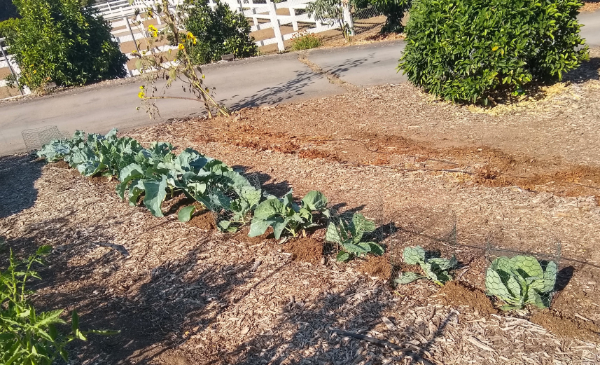
Above are cabbage, broccoli, and cauliflower plants. They need protection while young, but once they’ve filled the cages, the cages can be removed because the rabbits don’t find the older leaves of these plants so palatable. Notice that I’ve already removed cages from some plants in the photo.
Tulle fabric covering
Another way to protect these plants is with a covering of tulle fabric. For example, here are some broccoli and cauliflower seedlings under tulle fabric protection.

I also use tulle draped over carrots as soon as the seedlings emerge.
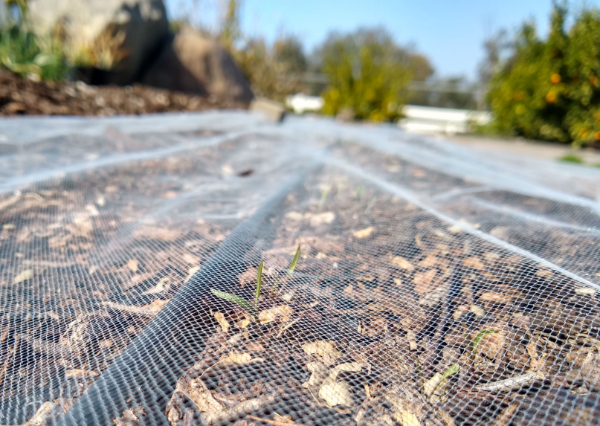
Every couple days you have to lift the tulle so the carrot tops don’t grow through and get stuck in the mesh. Otherwise, the carrot tops just push up the fabric as they grow.
Peas can also be protected with tulle fabric, but I try to keep the fabric above and out of reach of the plants because the pea tendrils will grab hold of the mesh. I use string between posts to suspend the tulle.
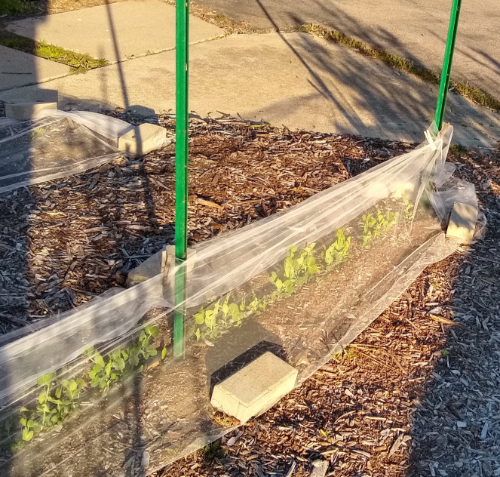
Why tulle instead of a row cover that is made for protecting plants? I like the tulle because it lets through almost 100 percent of the sunlight; most row covers or nets provide more shade. Tulle is also cheaper than products made specifically for gardeners or farmers although the tulle probably doesn’t last as long. I buy “Economy Colored Polyester Tulle in Bolts” from Papermart, and I buy a bolt 108 inches wide by 50 yards long, which costs $24 today. I then cut it to the width and length I need for different plantings. I also use this same tulle to protect fruit on my trees from birds. (See “Protecting fruit from birds.”)
One caveat on using tulle as a rabbit barrier is that occasionally I’ve had rabbits chew holes in it, especially when the plants are allowed to grow through the mesh. It seems that the rabbit is trying to eat the plant and inadvertently chews some mesh rather than first chew a hole in the mesh in order to get access to the plant within. So it’s important to lift the tulle frequently to prevent this.
Barriers for fruit tree protection
Rabbits like to chew on the lower leaves, branches, and trunks of young fruit trees so I protect them at planting time in two ways. Often a wrap around the trunk is all that’s necessary, and I’ve made them with different materials. Here is one I made using cardboard:
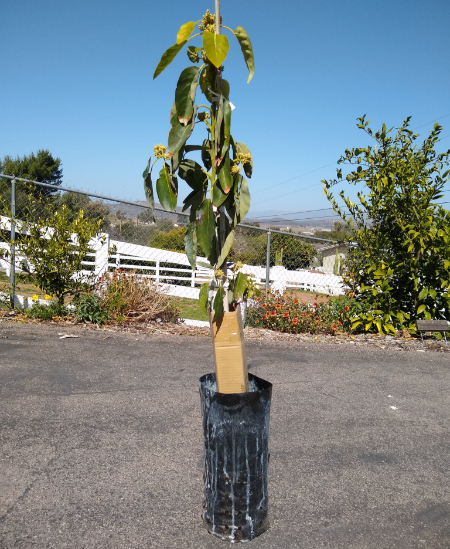
I also sometimes protect young trees with cages made of poultry wire. Here is a tree that is super protected, with a trunk-wrap plus a wide cage that keeps both rabbits and chickens out (so the chickens don’t scratch away the mulch):

Repellents
Can you rub or spray something on trees or plants to repel rabbits? I don’t know. I’ve never given it a serious try because what I’ve read doesn’t make this method sound as effective as barriers. (Read about repellents and more on rabbit management in general at the UC IPM page here.)
Predators
Predators of rabbits include hawks. Just this morning, my son and I spotted a red-shouldered hawk eating prey on top of the power pole near our yard. We investigated to find that the fur floating down was that of a cottontail.

We had an excellent cat for a few years that I saw eating bunnies many times. Before her, the rabbit damage to our vegetables was higher. Now after her, the rabbit damage is once again higher. But I also know other cats in other peoples’ yards that are poor hunters. Likewise with pet dogs, their usefulness as predators of rabbits varies.
(2022 update: We have a couple of new yard cats that are doing a great job of protecting our plants. The vegetables have had no damage since they arrived. The only downside is that they also love to use freshly raked beds as litter boxes!)
I don’t think it’s realistic to rely on predators to prevent rabbits from eating your vegetables and chewing on your young fruit trees, but they certainly help and I welcome most of them into our yard.
From time to time, I become a rabbit predator myself. Rabbits can be trapped, but mostly I kill them with a pellet gun. Rabbits are easy pickings at dusk or dawn, especially if you use a flashlight to cause their eyes to shine red. But I hate having to shoot the bunnies, even if I eat them. (See my post, “Eating the rabbits that eat my garden.”) It’s just that the natural predators don’t keep the population low enough sometimes and I feel the need to enter the food chain.
By far, my preferred method of protecting my vegetables and fruit trees is some form of a barrier.
All of my Yard Posts are listed HERE

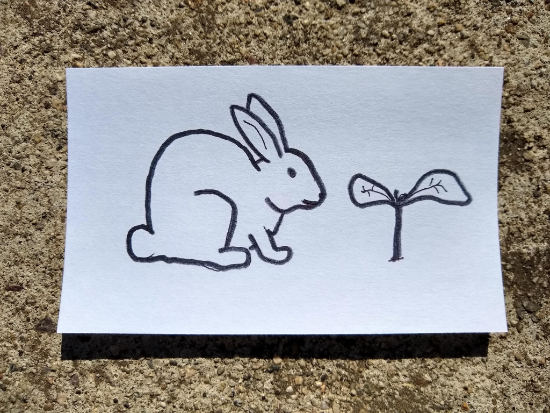


I do not have a rabbit problem but this year have had my lettuces and spinach eaten to the nub, and I think it’s lizards that are the culprit. I liked having them around the summer garden to eat bugs, but now they think the winter garden was planted for them. Chicken wire doesn’t keep them out. I’m testing one hoop with a white netting over it, which covers about 4 plants, but not sure yet whether this will work. Any other ideas?
Wow Bonnie, that sounds like the behavior of rabbits. How sure are you that it’s lizards? After putting up some chicken wire, have plants still been nibbled? Have you gone out after dark with a flashlight to see if there are any bugs or snails doing the damage?
I have a great number of lizards in my yard, and they’re constantly running through my vegetables, yet I’ve never seen them nibble on anything except insects. (Once I watched a lizard snatch a bee and gulp it down.) But maybe your lettuce and spinach taste better than mine!
Thank you for the information! Very helpful. I like the tule idea!
I don’t believe there are any lizards that are vegetarians..must be something else eating your veggies!
We don’t have rabbits on our property, and yes, I have done night searches for snails & slugs, so when my lettuce leaves were first being nibbled I wondered if it could be mice or rats. I was surprised to learn through a Google search and through talking with someone experienced with lizards that lizards not only eat lettuce, but that pet stores & vets actually recommend giving them dark green lettuces but not iceberg lettuce. Reportedly they also eat spinach, but my spinach crop has been weak this season and hasn’t tempted them. I’ve now put a row cover over the lettuce, which has solved the above-ground damage. Unfortunately, it hasn’t prevented a gopher from pulling down 2 lettuce heads a couple days ago, leaving only his tell-tale hole.
Gecko’s eat my succulence.
thanks Greg. I will try those little fences. But chickens are my culprits. and they are very bold and persistent. Any ideas for keeping them away so the plants have a fighting chance?
Yes, chickens can fly. That’s the greater challenge. I’d say the best way is to only let the chickens out of the pen for a stroll just before sunset. This means they only spend a little time out and about, and they return to the pen on their own at dusk. Otherwise, you have to build a screen over the top of the vegetables.
thanks for this! I just panted my first veggie garden and despite fencing around our entire yard, they still get in. I will try your methods.
I love my rabbits, they are welcome in my garden because I delight in watching them hop around. I’m basically experimenting with what I can grow that they won’t touch. So far they won’t eat my bell peppers, tomatoes, squash. They’ve decimated my bush beans, malabar spinach, kale, collared greens and broccoli. For some weird reason they like munching on citrus leaves so I always cut some off and leave them on the ground. They are also welcome to any jujube and guava fruit that falls on the ground. I finally had to kill some rats that chewed a hole in my Urban Worm Bag and had an all-you-can-eat worm buffet. I take the carcasses from the traps and leave them on my deck. The ravens fly off with them in the morning.
I forgot I wrote this
add kaboucha squash (japanese pumpkin) to the OK list, so far they’ve left mine alone
I also grew dino kale in containers then planted them out where the rabbits can only get at the lower leaves and now they can’t reach the ones growing. Plant is now about 3′ tall and can grow as high as 8 or 10 I believe, huge leaves. I will have seeds this year and can send you some Greg.
Will my cabbage still grow if only partial damage by rabbit?
Hi Lynn,
Yes, unless the rabbit has chewed down the center of the cabbage plant where new leaves grow from.
I have basically started planting beans for my resident bunny in an attempt to keep it from eating other things. That being said my Brussels sprouts are being eaten. Do rabbits typically like Brussel sprouts?
Hi Susanna,
Rabbits love Brussels sprouts, and every other similar plant, such as broccoli, cabbage, and cauliflower. Like I mentioned in the post, I deal with this by making small cylinders of poultry wire for individual brassica plants. Once the plants are at least a foot wide, I can take the cages off and the rabbits are less attracted to them. (I think it’s because the leaves are no longer as tender and sweet.) From then on, the plants almost always go untouched by the rabbits.
I started planting in raised containers which stopped the rabbits, but did nothing to deter the rats or squirrels. I’d love to hear solutions for those creatures too. I’ve tried bird netting which they easily chew through.
Hi Christine,
The cat I mentioned in the post above was the best solution for rats. Wish I could have cloned her and sold copies to all gardening friends. Without her now, I use the simple, traditional traps for rats and mice like these (my preferred bait is a piece of cashew nut): https://www.victorpest.com/victor-easy-set-rat-trap-bm205
For squirrels, check out this post (and make sure to read the excellent suggestions from others in the comments section too): https://gregalder.com/yardposts/dealing-with-squirrels-in-a-food-garden/
I assume having a pet stoat is illegal? lol I watch videos on them they are the most adorable serial killers ever, they just go around killing EVERYTHING and they mostly feast on the brain so if you ever wanted to dine on what’s around you a stoat would be the BEST!! Just go around collecting the brainless carcasses of your rabbits and quail and squirrels.
Hi Greg,
I don’t have rabbit problems but wanted to thank you for all the information on this site! It has been very helpful in starting our first garden. Do you have any general tips or strategies for gardening near the ocean (<1 mile)? Our soil is very sandy and seemingly short on nutrients. I'm considering mixing in a few bags of 'soil amendment' from Home Depot. Thanks again.
Hi Tyler,
Thanks! I can empathize with your sandy soil situation, as my previous garden was similarly close to the ocean and with similar soil. I added lots of compost, that was my main strategy. At first, I mixed the compost into the soil, but later I just added layers to the surface.
Pretty much any plant material added to the sandy soil will help, whether it’s your own homemade compost, purchased bags from a place like Home Depot, or wood chips added to the surface as mulch. Sandy soil eats this stuff up surprisingly fast.
And one thing I slowly learned NOT to do was plant on mounds. Since the soil already drained so rapidly, I realized that raising my plantings was only exaggerating the water drainage and requiring me to water even more frequently. Unfortunately, a number of plants suffered for a few years before I realized this.
Thanks Greg! Tried woodchips under the pomegranate tree, and a layer of compost where the in-ground corn will go. Cheers!
I mounded my mango and was astonished at how fast it dried up and how much I had to water it and it STILL died 🙁 but most likely disease not for lack of water!
Using that mound now to grow squash now.
I have a compost question.
I have a ton of leaf litter under my two pepper trees accumulated over the last 40 years, yet nothing much seems to grow under them. Should I add this leaf litter to my compost heap, or is there something in it that inhibits plant growth?
Hi Marilyn,
I would add it to my compost. I’ve used lots of chipped pepper trees without seeing any problems.
I have a huge rabbit problem and agree with you on physical barriers being best. They also go for my wife’s roses with gusto as well as my veggies. I have heard of a rabbit virus that is in San Diego county and wonder if you have any info on it. I know that the rabbit lovers are really concerned about it affecting their prized pets. I am hoping it will get up my way in Santa Barbara and make a dent in the wild population.
Hi Axel,
I hadn’t heard about that rabbit disease (RHDV-2). It certainly doesn’t seem to be present in my neighborhood yet, judging by the high population of healthy cottontails running around.
Great post! I have read in other places about the benefits of using tulle in the garden. Now, you’ve inspired me to order some and try it out in our permaculture paradise (well, it’s just a lawn covered in wood chips right now, but look out! it’ll be something someday!)
Thanks for the info and various ideas, always helpful.
no fences or protection in my yard I either grow more for the rabbits or figure out what they won’t touch.
They ate all my vines like watermelon, cantaloupe, honey dew, passion fruit
I was able to grow Yellow Summer squash and so far they have left my kaboucha (japanese pumpkin) alone which I am trying this year. Made a pumpkin curry soup with one and now I love them 🙂
They ate up my young Moro Blood Orange tree but seemed to leave it alone I started dumping coffee grinds around it and leaving citrus peels around the trunk.
We have hawks and eagles that keep the population in check, the friendly ones don’t survive 🙁
Had a bunny that would eagerly run towards me when I brought out apple slices and one day a hawk took him just as he was bounding across the yard towards me.
Do you have any tips for keeping rats and squirrels out of fruit trees? They damage a lot of my oranges. I try to keep low branches cut and also keep branches a distance from nearby chain link fence.
Hi Vickie,
Practically speaking, the only way to keep rats and squirrels out of fruit trees is to eliminate them from your yard — that is, kill them. Both are incredibly good climbers. But this doesn’t necessarily mean that you have to personally kill them. If you get the right cat or dog, they can do the job, for example. Anyway, here’s my post on dealing with squirrels: https://gregalder.com/yardposts/dealing-with-squirrels-in-a-food-garden/